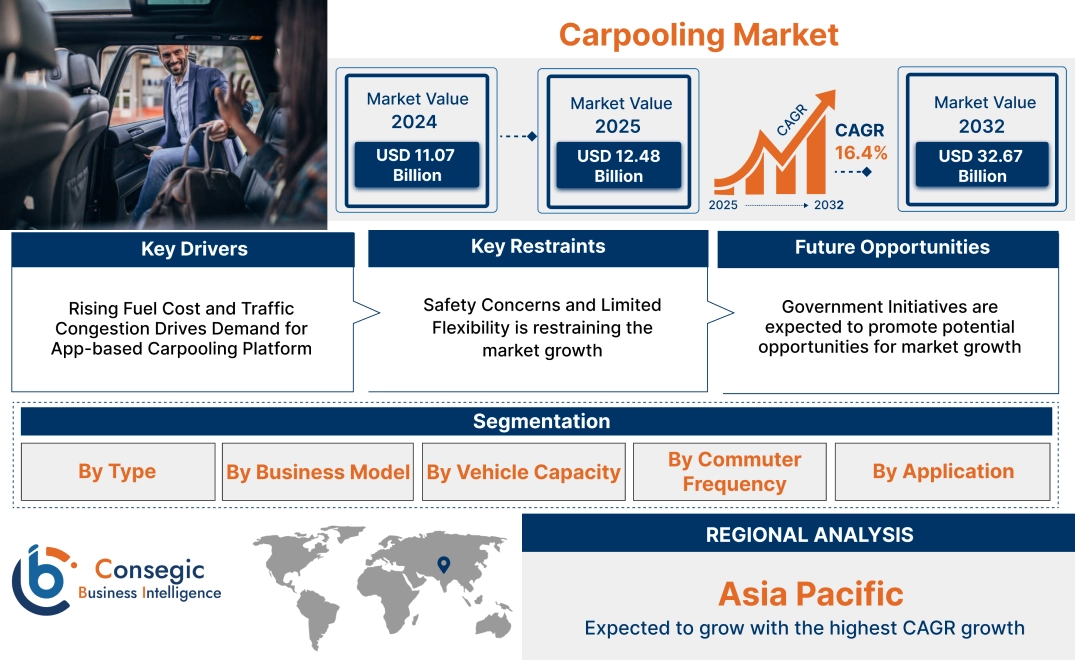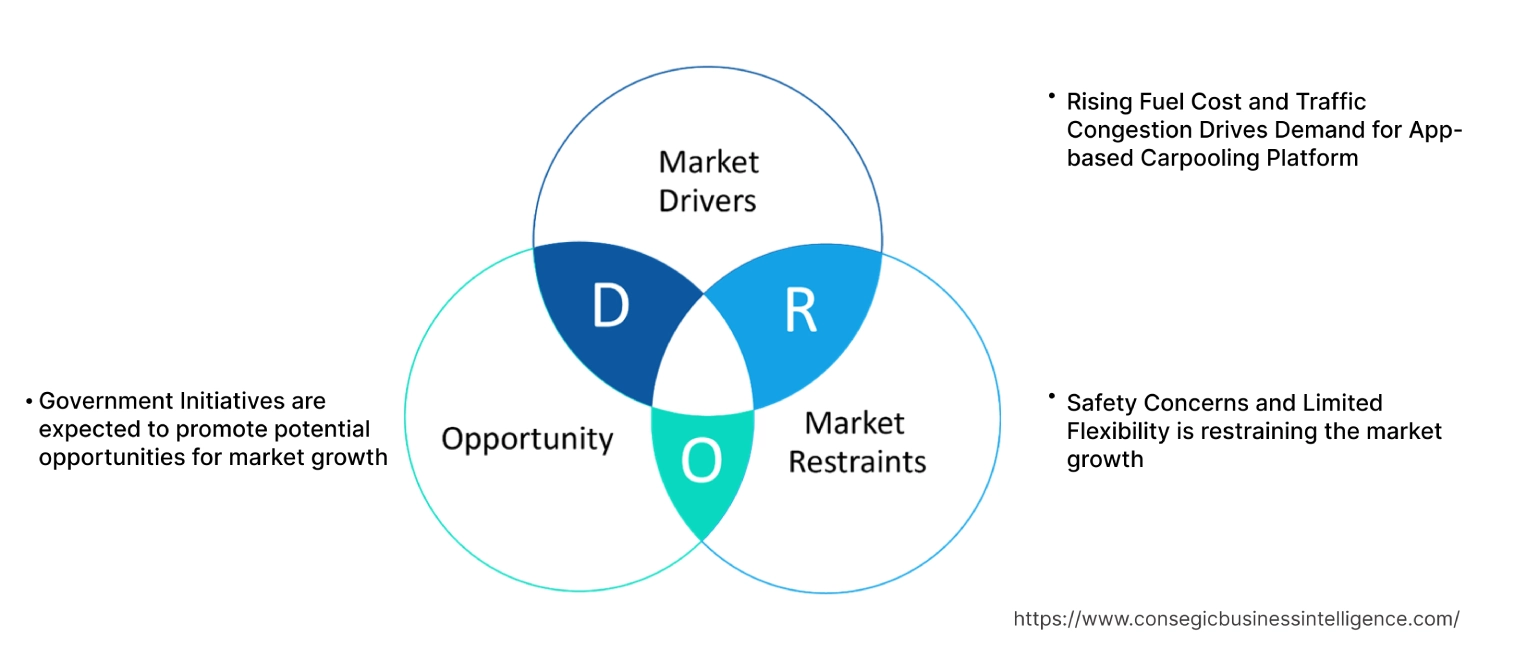- Summary
- Table Of Content
- Methodology
Carpooling Market Size:
Carpooling Market size is estimated to reach over USD 32.67 Billion by 2032 from a value of USD 11.07 Billion in 2024 and is projected to grow by USD 12.48 Billion in 2025, growing at a CAGR of 16.4% from 2025 to 2032
Carpooling Market Scope & Overview:
Carpooling is a method of sharing car by a group of people travelling together, eliminating the need for excess vehicles as well as reducing traffic congestions and vehicle emissions which in turn saves cost and environment. Additionally, the benefits including reduced traffic congestion, reduced parking issues, increased fuel efficiency, reduced emissions, cost saving among others are driving the carpooling market growth. Further, the rising fuel cost and traffic congestion is driving the carpooling market demand.
Key Drivers:
Rising Fuel Cost and Traffic Congestion Drives Demand for App-based Carpooling Platform
The increasing traffic and fuel cost is propelling the adoption of car sharing services as well as integration of service within the app helps to connect with passengers easily in turn driving the carpooling market growth. Additionally, the advantages of adopting app based car sharing services include enhanced convenience, reduced stress, promote sustainability among others which in turn boost the carpooling market demand.
- For instance, in December 2024, BlaBlaCar launched Zen, aims to fill a gap in carpooling services by short distance ride by integrating the service with app for automatically connecting passengers with drivers whose routes align.
Therefore, the increasing traffic and fuel cost as well as adoption of app based services is driving the carpooling industry, in turn proliferating the growth of the market.
Key Restraints:
Safety Concerns and Limited Flexibility is restraining the market growth
The idea of sharing a ride with strangers rises safety concerns, which in turn hinders the carpooling market expansion. Also, car sharing requires coordination and agreement regarding pick-up and drop-off times and locations as well as sometimes the ride gets cancelled due to emergency which hinders the market adoption.
Therefore, the rising safety concerns and limited flexibility are restraining the carpooling market expansion.
Future Opportunities :
Government Initiatives are expected to promote potential opportunities for market growth
The increasing awareness towards rising carbon emission is driving government to focus towards providing sustainable and affordable solutions which in turn is paving the way for carpooling market opportunities. Additionally, the government across the globe are promoting carsharing service by investing as well as changing motor vehicle guidelines for promoting adoption of carsharing services.
- For instance, in February 2025, Uber launched Uber Saarthi, by collaborating with Government of Assam which provided a funding of USD 1.2 billion and promoting carsharing service under motor vehicle guidelines.
Hence, the increasing awareness and government support is anticipated to increase the utilization, in turn promoting prospect for carpooling market opportunities during the forecast period.
Carpooling Market Segmental Analysis :
By Type:
Based on the type, the market is segmented into economy, executive, luxury, and others.
Trends in the Type:
- The subscription pricing and fractional ownership business models are offering consumers more flexibility in turn driving the adoption of luxury type segment.
- The increasing demand for convenient mobility options is driving the adoption of economy rides which in turn is boosting the carpooling market trend.
Economy accounted for the largest revenue share of 38.95% in the year 2024.
- The economy type ride sharing is a cost-effective way of saving on fuel, toll, and parking where participants split the expenses to reduce individual costs.
- Additionally, the advantages of adopting economy type rides include reduced traffic congestion and lower carbon emissions in turn driving the carpooling market share.
- Further, the economy rides also include informal booking between colleges, friends and others drive the carpooling market size.
- Thus, according to the carpooling market analysis, cost-effective solution is driving the adoption of economy type rides.
Executive is anticipated to register the fastest CAGR during the forecast period.
- The rising adoption of car sharing services to take care of enterprise travel as well as offering real time booking with expense details is driving the carpooling market share.
- Further, the increasing focus towards improving operational efficiency to profitability is paving the way for executives type rides promotion, which in turn drives the carpooling market size.
- For instance, provides executive type rides for corporate by providing features such as app based booking, real time booking, among others.
- Therefore, as per the market analysis, the rising adoption in enterprise travel is anticipated to boost the adoption of executive type rides during the forecast period.
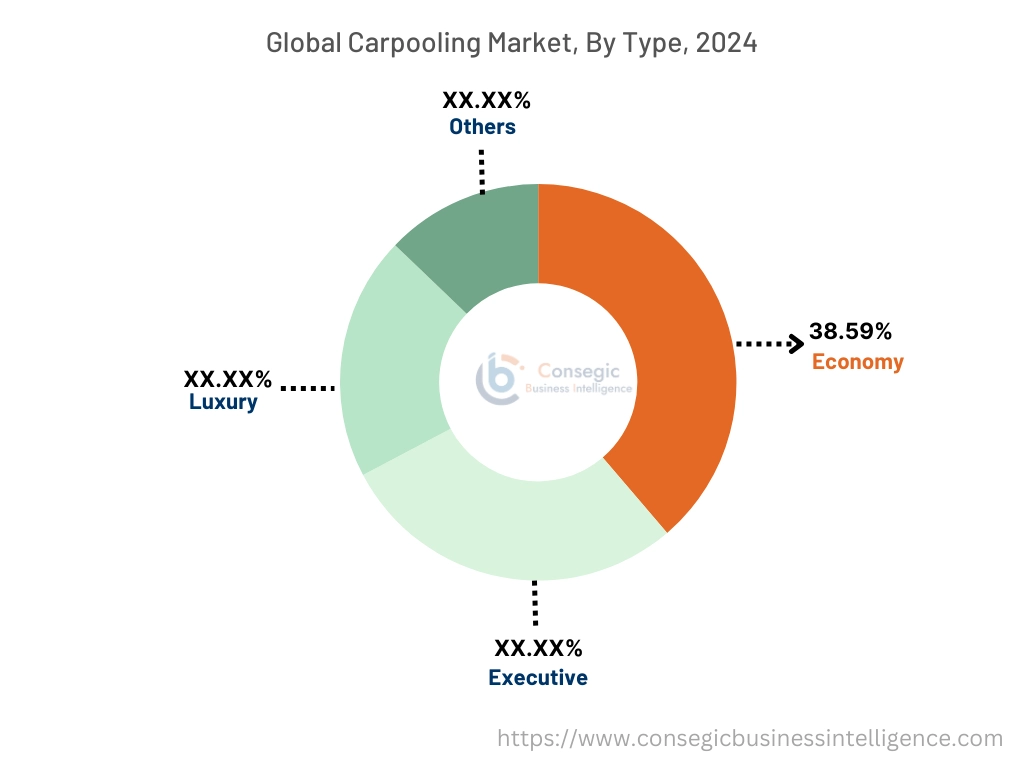
By Business Model:
Based on the business model, the market is segmented into P2P, station based, and free-floating.
Trends in the Business Model:
- The trend towards increasing focus towards sustainability is driving the adoption of free-floating business models due to flexibility.
- The station based business model supports convenience and practical daily use for urban mobility which in turn drives the carpooling market trend.
P2P accounted for the largest revenue share in the year 2024.
- The P2P business model helps to reduce traffic congestion, lowers transportation costs and improves air quality as well as offer convenient and affordable ways of commuting, especially in urban areas.
- Further, the increased adoption of electric vehicles and technological advancements such as blockchain and AI integration is driving the growth of P2P business model.
- For instance, companies providing P2P business model include BlaBlaCar, Lyft, and others for facilitating convenient transportation solutions through mobile app platforms.
- Thus, as per the market analysis, increased adoption of electric vehicles and technological advancements is driving the P2P business model segment.
Station Based is anticipated to register the fastest CAGR during the forecast period.
- The station based business model involves sharing a vehicle with other people who are traveling on the same route.
- Additionally, the collaborative approach between the passenger and driver in turn saves cost, reduces emissions, and promotes sustainability is driving the station based business model segment growth.
- Therefore, according to the carpooling market analysis, the collaborative approach saves cost, reduces emissions, and promotes sustainability are anticipated to boost the market during the forecast period.
By Vehicle Capacity:
Based on the vehicle capacity, the market is segmented into small cars (4-6 seats), mid-size cars (7-9 seats), and vans (10+ seats).
Trends in the Vehicle Capacity:
- The van segment is growing due to sustainable and cost-effective commuting options by sharing the expenses between the passenger and driver.
Small cars (4-6 seats) accounted for the largest revenue share in the year 2024.
- The small cars vehicles are majorly utilized for daily commutes due to increased convenience, reduced cost, and others.
- Additionally, the rising adoption of compact electric vehicles is driving the progress of small car segments.
- For instance, in October 2021, Mobilize launched Mobilize Share in France. The company offers all-electric, compact urban car-sharing services with 4 seats, and a range of 230 km.
- Thus, as per the market analysis, rising adoption of compact electric vehicles is driving the small cars vehicles capacity segment.
Mid-size cars (7-9 seats) is anticipated to register the fastest CAGR during the forecast period.
- The rising adoption of carsharing services in business is driving the adoption of mid-size cars for commute. Also, the growing tourism industry is driving the adoption of mid-size cars for long distance travel.
- Further, the mid-size cars is an eco-friendly way to travel, eventually reducing the number of cars on the road and minimizing carbon emission is driving the mid-size cars segment.
- Therefore, as per the market analysis, the growing tourism industry is anticipated to boost the market during the forecast period.
By Commuter Frequency:
Based on the commuter frequency, the market is segmented into daily commuters, weekly commuters, and occasional commuters.
Trends in the Commuter Frequency:
- The occasional commuters are those requiring long distances travelling or an affordable alternative is driving the market adoption by occasional commuters segment.
- The trend towards emergence of mobile apps and online platforms is driving the market trend for occasional commuters segment.
Daily commuters accounted for the largest revenue share in the year 2024.
- The service is a flexible and efficient alternative to public transportation or driving alone, especially for daily commute in turn driving the daily commuter segment.
- Further, the rise of subscription based car sharing services is driving the adoption by daily commuters segment.
- For instance, in April 2023, BlaBlaCar acquired Klaxit to offer short distance daily commuting service across France. Additionally, Klaxit also supports 350 other companies to facilitate employee commute.
- Thus, as per the market analysis, rise of subscription based car sharing services is driving the daily commuters segment.
Weekly Commuters is anticipated to register the fastest CAGR during the forecast period.
- Weekly commuters prefer flexibility, convenience, and cost saving alternatives which in turn drive the market adoption.
- Further, the increasing penetration of app based car sharing services is driving the adoption by weekly commuters segment.
- Therefore, as per the market analysis, the increasing penetration of app based car sharing services is anticipated to boost the market during the forecast period.
By Application:
Based on the application, the market is segmented into business and private.
Trends in the Application:
- The integration of micro-mobility options with car sharing is driving the market adoption in private segment.
- The rise in demand for corporate employee transportation solutions is driving the market adoption in business segment.
Private accounted for the largest revenue share in the year 2024.
- The proliferation of electric vehicles in P2P and free-floating business model is driving the adoption in private car sharing services.
- Additionally, the private car sharing provides flexibility in passenger matching and convenience among others in turn driving the adoption of private segment.
- Further, the proliferation of subscription based model is driving the adoption of private car sharing services in the market.
- Thus, the proliferation of subscription based models are driving the adoption of private segment which in turn is boosting the market progress.
Business is anticipated to register the fastest CAGR during the forecast period.
- Businesses leverage car sharing services to optimize employee transportation, reduce costs and save environment, among others.
- Further, the platform utilizes AI to optimize routes, and provide real-time traffic updates, enhancing efficiency and convenience in turn driving the market progress.
- For instance, in July 2024, Spacer Technologies acquired Scoop Technologies to launch Scoop Commute app for providing mobility services for individuals and large enterprises across the United States, Canada, and Australia.
- Therefore, the adoption of AI for route optimization is anticipated to boost the market during the forecast period.
Regional Analysis:
The regions covered are North America, Europe, Asia Pacific, the Middle East and Africa, and Latin America.
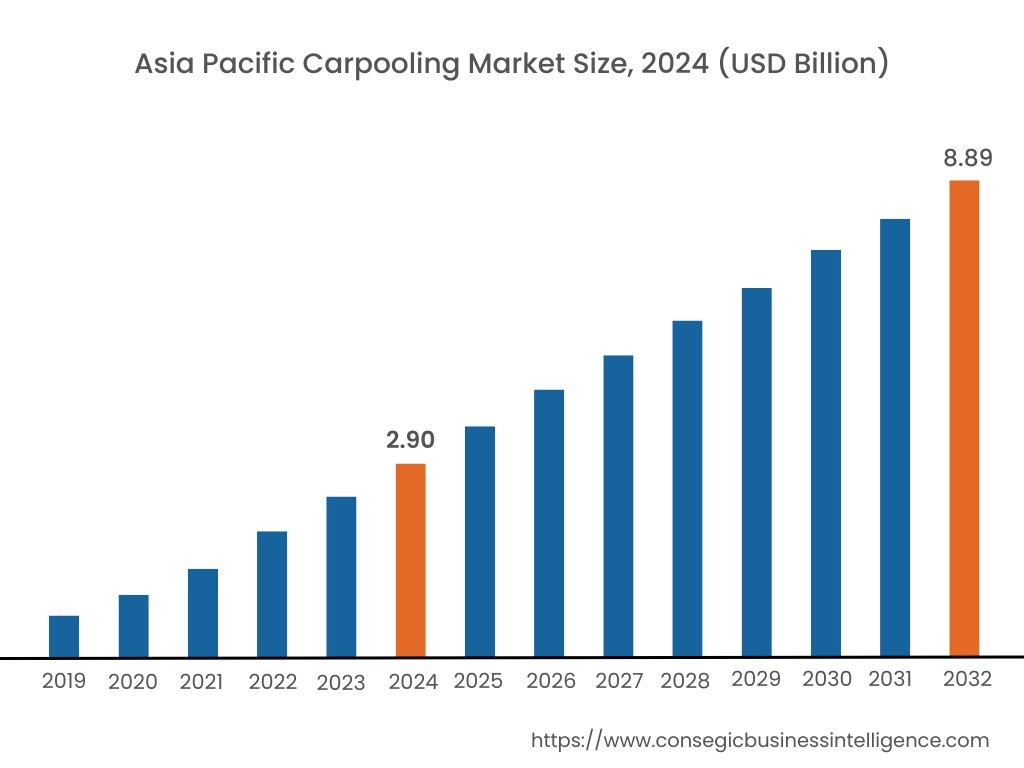
Asia Pacific region was valued at USD 2.90 Billion in 2024. Moreover, it is projected to grow by USD 3.28 Billion in 2025 and reach over USD 8.89 Billion by 2032. Out of this, China accounted for the maximum revenue share of 31.02%. The market progress is mainly driven by urbanization and rising fuel cost. Furthermore, factors including government initiatives and increasing investment to support car sharing are projected to drive the market progress in Asia Pacific region during the forecast period.
- For instance, in December 2024, according to Press Trust of India, BlaBlaCar is promoting the utilization of carpooling apps in India due to rising pollution and congestion levels.
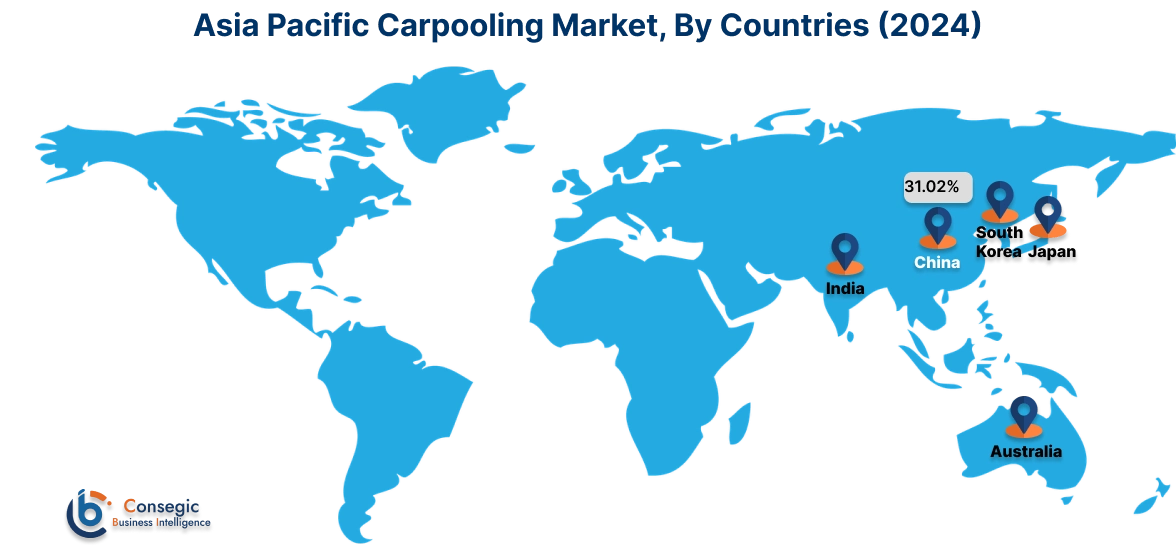
North America is estimated to reach over USD 10.65 Billion by 2032 from a value of USD 3.63 Billion in 2024 and is projected to grow by USD 4.09 Billion in 2025. The North American region's market is growing due to adoption of mobility-as-a-service offer lucrative growth prospects for the market. Additionally, the technological advancement and increasing focus towards reducing carbon emission among others is driving the market progress.
- For instance, in March 2020, Wunder Mobility launched employee carpooling service in North America aiming to reduce carbon emissions, save on parking space and make commutes easier.
The regional evaluation depicts that the proliferation of smart city programs is driving the market in Europe. Additionally, the key factor driving the market is rising vehicle cost and increasing urbanization in the Middle East and African region. Further, the adoption of technological for efficient driver-passenger matching is paving the way for the progress of market in Latin America region.
Top Key Players and Market Share Insights:
The global carpooling market is highly competitive with major players providing services to the national and international markets. Key players are adopting several strategies in research and development (R&D), product innovation, and end-user launches to hold a strong position in the carpooling industry. Key players in the carpooling market include-
- HOURCAR (USA)
- Getaround Inc. (USA)
- Ekar FZ LLC (UAE)
- DriveNow GmbH & Co. KG (BMW AG) (Germany)
- Zipcar Inc. (Avis Budget Group) (USA)
- Turo Inc. (ICA) (USA)
- Modo Co-operative (Canada)
- Mobility Cooperative (Switzerland)
- Lyft Inc. (USA)
- Locomute (Pty.) Ltd. (Australia)
Recent Industry Developments :
Collaborations and Partnerships:
- In December 2024, Dida Inc. partnered with JD Auto and JD Allianz Insurance for capitalizing automotive aftermarket services by leveraging Dida’s expansive carpooling user ecosystem.
Fundings:
- In May 2023, Natureo Finance advised ECOV for achieving USD 12.71 Million funding to accelerate the deployment of quality public mobility services for local communities.
Carpooling Market Report Insights :
| Report Attributes | Report Details |
| Study Timeline | 2019-2032 |
| Market Size in 2032 | USD 32.67 Billion |
| CAGR (2025-2032) | 16.4% |
| By Type |
|
| By Business Model |
|
| By Vehicle Capacity |
|
| By Commuter Frequency |
|
| By Application |
|
| By Region |
|
| Key Players |
|
| North America | U.S. Canada Mexico |
| Europe | U.K. Germany France Spain Italy Russia Benelux Rest of Europe |
| APAC | China South Korea Japan India Australia ASEAN Rest of Asia-Pacific |
| Middle East and Africa | GCC Turkey South Africa Rest of MEA |
| LATAM | Brazil Argentina Chile Rest of LATAM |
| Report Coverage |
|
Key Questions Answered in the Report
How big is the carpooling market? +
The carpooling market size is estimated to reach over USD 32.67 billion by 2032 from a value of USD 11.07 billion in 2024 and is projected to grow by USD 12.48 billion in 2025, growing at a CAGR of 16.4% from 2025 to 2032.
What specific segmentation details are covered in the carpooling report? +
The carpooling report includes specific segmentation details for type, business model, vehicle capacity, commuter frequency, application, and regions.
Which is the fastest segment anticipated to impact the market growth? +
In the carpooling market, the business segment is the fastest-growing segment during the forecast period due to adoption of AI for route optimization as well as providing real-time traffic updates.
Who are the major players in the carpooling market? +
The key participants in the carpooling market are HOURCAR (USA), Getaround Inc. (USA), Ekar FZ LLC (UAE), DriveNow GmbH & Co. KG (BMW AG) (Germany), Zipcar Inc. (Avis Budget Group) (USA), Turo Inc. (ICA) (USA), Modo Co-operative (Canada), Mobility Cooperative (Switzerland), Lyft Inc. (USA), Locomute (Pty.) Ltd. (Australia) and others.
What are the key trends in the carpooling market? +
The carpooling market is being shaped by several key trends including trend towards emergence of mobile apps and online platforms as well as increasing focus towards sustainability and other are the key trends driving the market.
